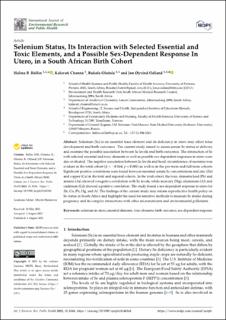| dc.contributor.author | Röllin, Halina B. | |
| dc.contributor.author | Channa, Kalavati | |
| dc.contributor.author | Olutola, Bukola | |
| dc.contributor.author | Odland, Jon Øyvind | |
| dc.date.accessioned | 2023-01-12T09:51:22Z | |
| dc.date.available | 2023-01-12T09:51:22Z | |
| dc.date.created | 2022-01-10T14:41:04Z | |
| dc.date.issued | 2021 | |
| dc.identifier.citation | International Journal of Environmental Research and Public Health (IJERPH). 2021, 18 (16), . | en_US |
| dc.identifier.issn | 1661-7827 | |
| dc.identifier.uri | https://hdl.handle.net/11250/3042923 | |
| dc.description.abstract | Selenium (Se) is an essential trace element and its deficiency in utero may affect fetus development and birth outcomes. The current study aimed to assess serum Se status at delivery and examine the possible association between Se levels and birth outcomes. The interaction of Se with selected essential and toxic elements as well as possible sex-dependent responses in utero were also evaluated. The negative association between Se levels and head circumference of neonates was evident in the total cohort (β = −0.164; p < 0.001) as well as in the pre-term and full-term cohorts. Significant positive correlations were found between maternal serum Se concentrations and zinc (Zn) and copper (Cu) in the total and regional cohorts. In the total cohort, the toxic elements lead (Pb) and arsenic (As) showed a negative correlation with Se levels, while mercury (Hg), aluminum (Al) and cadmium (Cd) showed a positive correlation. The study found a sex-dependent response in utero for Zn, Cu, Pb, Hg, and Al. The findings of the current study may inform reproductive health policy on Se status in South Africa and highlight the need for sensitive methods to measure Se intake during pregnancy and its complex interactions with other micronutrients and environmental pollutants | en_US |
| dc.language.iso | eng | en_US |
| dc.publisher | MDPI | en_US |
| dc.rights | Navngivelse 4.0 Internasjonal | * |
| dc.rights.uri | http://creativecommons.org/licenses/by/4.0/deed.no | * |
| dc.title | Selenium status, its interaction with selected essential and toxic elements, and a possible sex-dependent response in utero, in a South African birth cohort | en_US |
| dc.title.alternative | Selenium status, its interaction with selected essential and toxic elements, and a possible sex-dependent response in utero, in a South African birth cohort | en_US |
| dc.type | Peer reviewed | en_US |
| dc.type | Journal article | en_US |
| dc.description.version | publishedVersion | en_US |
| dc.source.pagenumber | 0 | en_US |
| dc.source.volume | 18 | en_US |
| dc.source.journal | International Journal of Environmental Research and Public Health (IJERPH) | en_US |
| dc.source.issue | 16 | en_US |
| dc.identifier.doi | 10.3390/ijerph18168344 | |
| dc.identifier.cristin | 1977666 | |
| cristin.ispublished | true | |
| cristin.fulltext | original | |
| cristin.qualitycode | 1 | |

